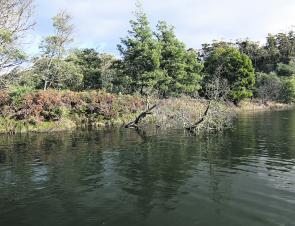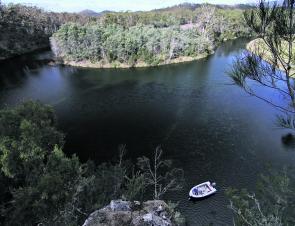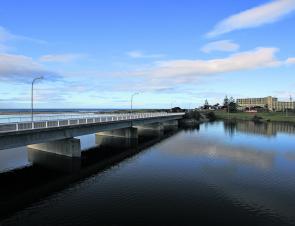Have you ever been travelling down a coastal highway, boat in tow, family in the back, kayaks on the roof, you whiz through a quint little seaside village and often say to yourself, “I wonder if its worth stopping here?”
Well Scamander is one of those small seaside towns that is definitely worth throwing out the anchors for. Scamander is situated 15 minutes drive south of St Helens on the northeast coast of Tasmania and has always been a popular Tasmanian holiday destination because of its wide, white sandy beaches and fantastic views of the ocean.
In 1825 a European surveyor named John Helder Wedge was the first person to visit the area. He originally named the river Borthwick and the area in which the township would later be built Yarmouth, after the English port Great Yarmouth.
In the years that followed both the river and town were renamed Scamander.
As travel up and down the coast increased, so did the complexities of the many river crossings. The Scamander River mouth is wide and shallow, which posed many problems. It had been a challenge to bridge builders for many years to come up with a reliable solution, until 1865 when Richard Terry constructed a timber bridge; however it later collapsed when a large mob of cattle was driven across it.
A second and third bridge was successively washed away in floods in 1889 and 1911 and many of the following bridges also succumbed to flooding and shipworms with the last timber bridge collapsing in 1929.
A steel truss bridge was built in 1936 and still stands today more as a popular diving platform for the kids to jump off in summer, a great fish attracting structure and a handy place to cast a line from.
The newer concrete bridge that currently carries the Tasman Highway was built alongside this bridge and serves as a great haven for fish around its large concrete pylon bases.
Scamander has another attraction that up until a few years ago was kept as a bit of a local known secret, the town is also located at the mouth of one of Tasmania’s premier bream fisheries, the Scamander River.
The Scamander River starts its life high in the hill country around 15km (in a straight line) north west of the township of Scamander. Here it is a small mountain stream alive with wild brown trout slowly winding its way down through the hills and valley slowly building in size until it hits a series of small weirs; the first being a freshwater collection point for the local reservoir supply and a great spot to cast for a trout or two.
The second weir is just above the Upper Scamander Bridge on the way to the Trout Creek Reserve and has been known to be a hot spot for whitebait to congregate and the odd large trout to be seen smashing the schools, the last one approximately 6km from town amongst private farmland and is long been destroyed by floods.
From here down, it’s prime bream country and, although as the crow flies this point is only 5.8km from the coast, it offers over 12km of winding tidal river in which to fish. As the river flows down towards the coast it grows larger, deeper and wider all the time offering a wide variety of locations for anglers.
The upper half of the river is generally shallow with numerous small rock bars that flow into deeper holes and sheer rock walls. There are also plenty of fallen tree snags to play in, some even stretching almost right across the width of the river and change from year to year depending on winter water flows and flooding. As you head further down river it gets progressively wider, the corners get deeper and the rock walls become larger with plenty of lure-swallowing tree snags.
From about mid river down the topography changes slightly and overgrown shrubbery and rock faces give way to muddy shallow banks where the bream feed on small crabs and baitfish, these areas can put on some fantastic fishing at times.
The lower reaches of the river, from the Upper Scamander Boat ramp down, are where more of the shore-based fishing is done as it’s easily accessed by road and you can virtually pull up in your car and fish from your back seat. Here the river is quite wide with good rocky and muddy shoreline as well as deeper mid river sections and tends to favour the bait fisher.
In this lower region there are also a number of shallow mudflats that are covered with only a couple of feet of water at high tide and, at times, can be covered in hard fighting bream; these are only accessed by boat or kayak at high tide.
The river slowly flows down to the mouth and bar way where it flows over the sand and out to sea. Depending on the time of year and the amount of rainfall the bar way can be open or closed up.
At the bottom it offers good sand flat and bridge pylon fishing for bream as well as some of the better ocean beach fishing in the region.
The lower reaches of the river can be accessed right in the township of Scamander near the road bridges. There is a large amount of shoreline for the land-based angler to access on both sides of the river as well as the main boat ramp and jetty.
Just south of Scamander is the turnoff to the Upper Scamander Road, a short drive brings the road alongside the river and up to a small boat ramp and jetty. There is around 2km of easily accessed shoreline for land-based anglers and families to fish.
About mid way up the river is a small off shoot called the Trout Creek Arm, this is a very small freshwater creek that opens up into a decent piece of river full of bank side shrubbery. It is also the location of the Forestry Tasmania Trout Creek Reserve camping area; this is a fantastic place to head to if you are planning on camping in a tent or with a camper trailer. There are basic facilities like picnic tables, fireplaces, a bush toilet, car park, small jetty and even a rough boat ramp suited to small dinghies or kayaks.
It has a great safe swimming area for kids, camp sites that are available right at the waters edge and makes the perfect family camping destination if you are after some tranquil fishing and light water activities.
The Scamander River is a typical east Australian river system and plays host to quite a number of different fish species. Small to medium-sized Australian, or ‘cocky’ salmon, are present in the lower half of the river all year round and at times schools of larger salmon will chase the migrating baitfish into the river for some exciting sport.
Silver trevally are another species that are often encountered and will school up into large groups offering great sport especially for kids fishing from the jetty and rocky shoreline at the mouth of the river.
Nevertheless, by far the most predominant species, and the one this river is famous for, is Acanthopagrus butcheri, or the southern black bream. The Scamander River traditionally has always been a great bream fishery but up until the late 1990s was really only well known to the East Coast locals.
Lure fishing for bream was almost unheard of at the time with bait fishing the popular technique. You would often hear of huge cricket score catches, unfortunately as was the culture back then catch and release was not high on the agenda.
But in the early 2000s something happened that put the Scamander River and lure fishing for bream on the main radar in Tasmania and has since grown into a huge sport and turned the river into one of the most popular playgrounds.
It was just after the Squidgy range of soft plastics had hit the market, at the time I was managing a tackle store in Launceston, Steve Starling and Kaj Bush had begun their Squidgy Tour travelling the country and promoting the new product. During their travel around Tasmania they had a small window of opportunity to do some fishing and headed to the East Coast to hook up with a local guide and sample the bream fishing of the Scamander River.
Starlo and Bushy certainly gave the locals an education on that day, catching and releasing up to 80 fish in only a few short hours and all on Squidgy soft plastic lures. This was a turning point in bream lure fishing in Tasmania and has since created a flourishing fishery – turning a ‘catch and kill’ culture into one of accepting catch and release.
Activity on the Scamander River is reasonable predictable throughout the year given there are no major flood events.
Autumn will see a migration of larger fish back into the river from other systems to start a winter run into the lower half of the river.
As spring approaches, male and female fish congregate up and down the river slowly moving their way to the headwaters.
As October and November arrive the bream will be in large schools waiting for the water temperature, salinity, algal growth and moon phase to all align and then they spawn en masse.
This takes place until early December where some of the fish leave the river and spread to other systems up and down the coast but left behind are a large number of smaller fish that spend the summer months milling about in the protective shade of bank side bushes and tree snags.
For the bait fisher, the Scamander River offers a great variety of fishing situations, anglers can choose to fish from either a boat or bank side.
Simple running sinker rigs are the norm with a size #6-1/0 hooks and a small pea-sized ball sinker let run down to the hook the most successful method for bank fishers.
Those targeting bream from a boat with bait should try and fish unweighted where possible and only use the smallest amount of lead for a casting weight.
Baits can vary and it always pays to have a few different baits at hand. Prawns, mussels, pipis, oysters, whitebait, pretty fish (small baitfish), crabs and freshly pumped nippers from the mudflats are all perfect baits for bream.
If there has been some rain and there is a little bit of runoff from the banks and drains, some garden worms can do the trick as the bream will swim about mopping these up as they are washed in from the paddocks.
If targeting bream with soft plastics it is almost a necessity to fish from a boat or kayak, unless working the flats at the mouth of the river, as it makes finding areas of the river where schools of fish are congregated much easier.
For the most part, a lot of the Scamander River has an abundance of fallen tree snags along its banks and sheer rock walls in between, which hold fish. The bream will sit around the snags and structure and along the face and the base of the rock walls. In these areas a soft plastic lure such as an 80-100mm Squidgy Wriggler rigged on a light 2g #4 head is ideal.
Cast into the structure or at the face of the wall and let drop down the action of the Wrigglers tail is irresistible to the bream. Let the lure sit on the bottom for a short while then a slow lift and drop retrieve back to the boat is all that is needed. The fish will either hit the plastic while it is on the drop or will grab it while it’s paused on the bottom.
If the bream are seen to be close to the water’s surface, which they will often be if the tide is moving and there is a bit of current moving through the structure, then change to a lighter head weight to keep the lure up in the strike zone for longer.
Two of my most successful colours in the Squidgy Wrigglers for the Scamander River are the wasabi and bloodworm patterns in the Pro Range series.
When bream are holding in the snags I also like to use the smaller crank style hardbody lures. A floating model is perfect for casting in amongst the snags and twitching it, letting it float over the twigs and branches and cranking back into the strike zone. If a bream shows interest, a pause is an absolute must; try and resist the urge to move the lure at all.
If fishing the rock bars, mud flats and shallow bank sides, the plastic lures will still work quite effectively however I favour the hardbody minnow lures for this type of fishing.
A 40-60mm long suspending bibbed hardbody lure is ideal for fishing the shallow water. It can be cast into the shallows and as most will only dive to a depth of around 1m and suspend they can be manipulated with the rod tip to keep them in the fishing zone for longer.
A variety of retrieves can work and it’s a matter of experimenting on the day to find out which one will draw a strike from the bream. Sometimes just a straight retrieve, slow roll back to the boat works, other times a sweep with the rod tip to cause the lure to swim and then a long pause while it suspends will drive the bream wild.
Depending on the time of year, the bream could be holding up in the snags, on the rock walls or even down on the bottom in the deep corners.
When targeting bream in deeper water and suspended schools of fish the Vibe style of lure is also very effective and should never be overlooked.
They can be fished slowly or quickly, in mid water or on the bottom and can also be rolled slowly across shallow mudflats. They are a very versatile lure that can often trigger a strike when it’s otherwise slow.
The Scamander River has a lot to offer all types of anglers. It’s great for the family with easy access and a huge population of bream, as well as some other species, it suits bait fishers, lure fishers and is a great river for launching a kayak and paddling your way up or down just taking in the lovely surroundings.
So the next time you are on the East Coast of Tasmania take some time out and stop off at the Scamander River, you might just be surprised.
Facts
Suggested Tackle
The Scamander River is typical of any east Australian coastal river system and suits light tackle bait and lure anglers.
Soft plastics and lure outfits: a fast action graphite 6’6” 1-3kg for hardbodies and light weighted plastics, and a 7’ 2-4kg for heavier weighted plastics and vibes. Matched to a 1000 sized spinning reel spooled with 3-4lb braid should see all scenarios accounted for.
Bait fishing outfit: soft action bream rods in the 7’6”-9’ 2-4kg are ideal matched to a 2500 sized spin reel spooled with some quality 6lb mono or 4lb braid.
A variety of small ball sinkers as well as some split shot, long shank and octopus style hooks in sizes #6-1/0 will cover most situations and spools of fluorocarbon leader in 4, 6 and 8lb.
Popular soft plastics lures: 80mm and 100mm Squidgy Wrigglers in wasabi and bloodorm, 6” Gulp Sandworms, 3” Gulp Fry and any 2-3” grub tail style lure.
Popular hardbodied lures: Bushy’s Stiffy Minnow in tassie tiger and prowler, Shimano Lure Project Minnows and Cranks, Atomic Bream Shad 40 and Lucky Craft Tango.
Popular vibe lures: 40mm Cranka Vibes and Bassday Kangoku Vibes.
Facts
Where to stay: Scamander Tourist Park is situated in the heart of the township of Scamander right on the main road and offers both onsite caravan and cabin accommodation with a fully stocked mini market and fuel.
Scamander Tourist Park
70-88 Scamander Avenue
Scamander TAS 7215
Phone: (03) 6372 5121,
For campers the Trout Creek Reserve camping area is a perfect place to pitch a tent or camper trailer and camp sites are available right on the waters edge. Just follow the signs on the Upper Scamander road just south of the township or check out the Forestry Tasmania website for detailed directions at:
http://www.forestrytas.com.au/visiting/visitor-sites/north-east/scamander-forest-reserve.
Facts
Charters
If a fishing charter is on the cards they don’t come much better than Michael Haleys Gone Fishing Charters. Michaels offers both estuary and coastal charters as well as being the big bream specialist.
Gone Fishing Charters
Phone / Fax: (03) 6376 1553, Mobile: 0419 353 041, www.breamfishing.com.au.
Facts
Fishing needs
For all your bait, tackle and boating requirements there is a well stocked tackle store in the township of St Helens (15 minutes north of Scamander).
St Helens Bait & Tackle
Phone: (03) 6376 2244, www.sthelensbaitntackle.com.au.

A typical bank and bream holding tree snag on the Scamander River.

Jamie Henderson fishing Pitts Corner. It is one of the many deep bends on the upper reaches of the Scamander River.

The old disused Scamander River bridge and lower boat ramp area.

The Scamander River Road bridge looking seaward.

What the Scamander River is famous for – bream.

Sean Gower with a 41cm big blue nosed Scamander bream. Fish like this put Scamander on bream angler’s must-visit list.

Simon Hedditch lifts a small lure-caught bream from the water.

A tranquil setting on the river’s upper reaches.




